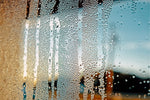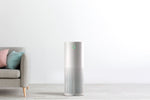Everything You've Wanted to Know About HEPA

Posted by Dr. Mansour Abdulbaki, PhD, Director of Science & Education
HEPA Explained
HEPA stands for High-Efficiency Particulate Air (filter). This is not a marketing claim but an actual certification label with standardized and very strictly tested performance requirements.
What makes it a HEPA filter? The Performance.
During manufacturing, every single HEPA filter is tested 2-3 times each, depending on the certification standard, to ensure it meets the stringent performance required of the HEPA certification which is to capture a minimum of 99.97% of particles that are 0.3 microns in diameter. That particular size is chosen because ratings for these filters are based on the worst-case scenario – meaning that 99.97% is the minimum performance for HEPA filters against ALL particle sizes from the nanoscale to larger particles.
How does HEPA work?
Simply put, HEPA filtration is a physical process wherein a fan draws in air and drives it through a felt-like mesh of fibers, but don’t think of them like screen door filters. More accurately they are random webs of microfibers that inherently hold a surface charge to them. Each layer is so thin that the final few-millimeters-thick filter is actually composed of hundreds of layers of these webs - and that is key to their efficacy. Even though there are pathways for air around the fibers, the paths are so convoluted that particles of all different sizes find their way to getting captured by at least 1 of 4 main mechanisms. Each of those mechanisms differs according to the size of the particles in the air.
These particle capture regimes and how they work are described below by largest to smallest particles.
1. Sieving
Sieving occurs when fibers are so closely spaced and particles are so large that they cannot geometrically fit through the spaces between fibers and become lodged. This mechanism works predominantly on particles about 2 microns and larger. Particles remain stuck due to physical entrapment.
2. Impaction
Particles of about 0.5 microns or larger are heavy enough that even as air moves through the filter media and changes direction to flow around the fibers, the inertia of these particles carries them forward despite the directional change of the air carrying them, causing them to impact the fibers of the filter and stick in place. These particles remain captured due to electrostatic adhesion.
3. Interception
Medium sized particles without enough inertia to ignore the sudden twisting and turning of the air streams, continue to follow the air flow lines as they go around the filter fibers and are eventually trapped when they come into contact with the fiber along their way around them. The particles remain adhered due to electrostatic and van der Waal interactions.
4. Diffusion
Particles smaller than about 0.25 microns are so light they do not actually flow with the air exactly. They may follow the general direction while also diffusing through the air and the filter pathways until they make contact with a fiber and become trapped through adhesion governed by van der Waal forces.
The four mechanisms are shown graphically in the figure below.

The combined result of the four methods of filtration yields exceptionally high filtration efficiency of micro and nano-particles, with a NASA study confirming that HEPA filters provide “superior performance for removing virtually 100% of particulates”.
The reason you will see the metric of trapping 99.97% of 0.3 micron particles is that scientists report the performance of the worst-case scenario.
For HEPA filters, there is a phenomenological "weak point" at particles of sizes near 0.3 microns. Particles smaller and larger than this are more easily trapped by a HEPA filter with higher and higher capture efficiency as the particles get further - smaller or larger - from 0.3 microns.

So, ratings for these filters are based on the worst-case scenario – meaning that 99.97% is the minimum performance for HEPA filters against ALL particle sizes from the nanoscale to larger particles. Put another way, you will never see more than 0.03% of particles of any size pass through a HEPA filter.
For example, if you had 10,000 particles of 0.3 microns in diameter pass through a HEPA filter, a maximum of 3 out of the 10,000 particles would be allowed to pass through the filter. For particles larger and smaller than this size, even at the nanoscale, this would be even less i.e. 0, 1, or 2 particles per every 10,000.
If you had 10,000 particles of 0.3 microns in diameter pass through a HEPA filter, a maximum of 3 out of the 10,000 particles would be allowed to pass through the filter.
While we at JASPR have been focused on helping healthcare providers and business owners clear the air in their places of work to protect the health and safety of their staff and clients for several years now, the spotlight on clean air is really shining now because of questions about COVID-19. A March 2020 study published in the New England Journal of Medicine, showed the COVID-19 virus can stay viable and aerosolized for several hours. So, here is an explanation for the big question:
Can HEPA filters capture COVID-19?
The short answer is YES.
Here’s why:
COVID-19 primary particles or "virions" have been measured at about 0.1 microns (~100nm) and HEPA filters capture this range of particle sizes remarkably well ( >99.98% in a single pass). However, primary virus particles are not typically found on their own in the air. Virus particles ejected from an infected person are more likely to be found hitching a ride on larger particles in the form of aerosolized water droplets around 1 micron or larger with some recent studies showing viral material in healthcare air spaces in the >4 micron droplet range. While evaporation occurs for airborne virus-carrying droplets, the viral residues can remain aerosolized. Based on the discussion of HEPA filtration efficiency above, it is clear that, whether as a primary particle or attached to other droplets, HEPA filters can play an important role in significantly reducing the airborne population of virus and virus-carrying aerosols by 99.97% or more.
As discussed, of the four capture mechanisms in HEPA filters, the one that dominates for virus-sized particles is diffusion. Larger bioaerosols carrying the virus will be captured through contributions from the diffusion mechanism as well as interception and impaction as the particles in question are larger in size.
While HEPA filtration does not eliminate the threat the virus poses to human health, it is clear from the above discussion that HEPA-powered Air Purifiers can be used to reduce the risk of spreading COVID-19.
Other protective measures are highly encouraged in conjunction with HEPA-based air purification, including washing hands with soap and warm water for a minimum of 20 seconds, avoiding touching the face, social distancing, and sanitization of possibly contaminated surfaces like tables and clothes using a cleaning spray or wipe.
Do I really need to use a HEPA-certified air purifier in my practice or business?
With hundreds of scientists around the globe citing data and urging the WHO to recognize that COVID-19 is an airborne biohazard, using a certified HEPA-powered filter to purify the air in at-risk spaces should be part of your standard protocol to protect the health of your patients, clients, and staff from this and other microbiological vectors to – just like your protocols for cleaning and sanitizing surfaces.
Moreover, active air purification is becoming both an expectation from the public and a compliance requirement from governing and professional organizations. In the wake of COVID-19, many industry bodies are releasing guidelines around air quality in health practices, schools, and businesses. While many of these guidelines provide differing advice, one thing remains consistent: the importance of HEPA filtration.
Ready to see the performance of an air purifier that provides clean air and communicates that performance to increase confidence in your efforts to provide clean air? Check out Jaspr.co



